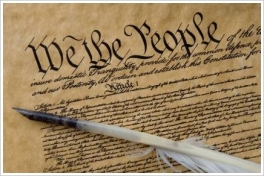History Revisited
Constitution Day
 The Constitution of the United States of America (PDF): Link
The Constitution of the United States of America (PDF): Link
Each year, September 17 marks the day the U.S. Constitution was signed as the supreme law of the land in 1787. The proceeding week is known as Constitution Week (from September 17 to 23). The day was first recognized by a joint resolution in Congress on February 29, 1952. Another resolution was passed on August 2, 1956 which requested that the President of the United States of America proclaim each period beginning September 17 and ending September 23 as “Constitution Week”.
More recently with the Consolidated Appropriations Act of 2005, Congress officially mandated that any educational institution receiving federal funding, must have appropriate educational programs for Constitution Day. Before the 2005 law, this day was previously known as Citizenship Day.
The Gadsden Flag and Other Revolutionary Banners
By now, unless you are a complete nincompoop, you know about the Gadsden Flag. But what you may not know is how it came about. To do this we must venture back to the period of the American Revolutionary War. The famous yellow “Don’t Tread on Me” flag (right) prevalent at many a Tea Party event was created by and named after American Revolutionary War General Christopher Gadsden. The banner was the first ever flown alongside the Continental Marines during the American Revolution.
The rattlesnake, though, was not necessarily an original idea from General Gadsden. It was in 1751, that one of America’s most prominent Founding Fathers, Benjamin Franklin created a political cartoon of sorts in the Pennsylvania Gazette (his personal publication). This cartoon (left) depicts the 13 original colonies divided into segments of a rattlesnake to show unity in the struggle for independence.
There are other incarnations of flags depicting the rattle snake. One militia group formed in 1775, known as the Culpeper Minutemen out of Culpeper, Virginia, fought under a similar banner to the Gadsden Flag. The Culpeper flag (right) depicts the phrases “Liberty or Death” and “Dont Tread On Me” as well as the coiled rattlesnake.
The other flag depicting the rattlesnake was the First Naval Jack, the first flag flown on United States naval vessels. The first ships commissioned by the Continental Navy bore this flag. This flag displays a yellow and red snake on a backdrop of the 13 stripes commonly seen on American flags.
The Federal Income Tax
As probably one of the biggest reasons for businesses to relocate from the U.S., the income tax for individuals and businesses (35% top tax rate) is outdone only by Japan (39.5% top tax rate) which faces it’s own extreme economic conditions. The first such tax in the U.S. came about in 1862, believe it or not, as a levy on the salaries of federal officials. We have come so far since then. With the dawning of the Progressive Era, there was a rise in the attitudes of many politicians that the rich kept too much wealth. By 1913, the focus of income taxes moved from a government-only focus into a new scheme to bring in more “revenues” to the government. In that year a new amendment was added to the Constitution (meaning it could always be repealed like Prohibition), Amendment XVI. This amendment states:
The Congress shall have power to lay and collect taxes on incomes, from whatever source derived, without apportionment among the several States, and without regard to any census or enumeration.
Disregarding the census (an idea added to the Constitution by the Founders) does not sound like something of which they would approve. Believe it or not, conservatives by early 1900s standards were the greatest supporters of this progressive legislation. Starting off low, the federal income tax reached astronomical levels during World War I under the administration of Woodrow Wilson. Conservative groups in Congress were able to lower it during the Roaring 20s. Starting with Republican president Herbert Hoover, income taxes were once again raised and only increased more under progressive president Franklin D. Roosevelt during World War II. Because government just loves its peoples’ money, the withholding tax was created in 1943 to tax each citizen’s paychecks instead of waiting for a whole year on tax day.
Under the presidency of Ronald Reagan, during the 1980s, the income tax rate had dropped exponentially, leading to a time of economic boom. The amount of GDP that is absorbed by federal taxes has remained constantly around 20% since the 1950s. See this chart for Hauser’s Law.
Today, as mentioned previously, the U.S. has the second highest tax rates on income in the world, even more so than the socialist nations of Europe. The federal income tax rates range from 10% to 35% of one’s yearly income. And yes, these taxes are enforced by everyone’s favorite tax collector, the IRS. (See Ron Paul on this one)
In addition to the federal government’s income taxes, states and localities took their queue from the federal government and now enact their own income taxes in addition to federal income taxes.
I will have future posts regarding the flat tax and fair tax, both of which many conservatives seem to support.
The Early Anti-Slavery Movement
Many people believe that slavery never even came up as an issue in the founding of our nation. Sure, we all learned that the North did not partake in slavery too much and the South depended on them for agricultural purposes. We know the Civil War was fought predominantly over slavery. But, most of us were never taught about the actions by early American patriots. We all know the Thomas Jefferson and Sally Hemings story, but little is known regarding the founding document called the Constitution. One provision which later came to be known as the Three-fifths Compromise. On its face it may seem like a pro-slavery provision. Partially it was, but this was the only way to unify the northern and southern states during the Philadelphia Convention of 1787. There were many in both the North and South who declared slaves as having human qualities and some even called them directly as such. During the discussion of federal taxation, the North wanted slaves to count as 3/4 of a person, while the South wanted this fraction to be 1/2. Interestingly enough, when it was determined that slaves (property) would count as part of the U.S. Census, the South wanted slaves to count as another person, so that they would have a larger voting share over states in the North regarding the plight of slavery.
The final fraction determined by a congressional compromise was 3/5. This measure did temporarily put the topic of slavery on the back burner, but it would take a Civil War to finally end the abhorrent practice.
John Quincy Adams was an early opponent of slavery and in 1820, he attempted to prevent new states from becoming slave owning states, promoting a huge debate with his former friend John C. Calhoun. Adams encouraged legislation in Congress that would call for the end of slavery much to the chagrin of the southern representatives. Southern states wanted so-called “gag rules” to prevent any such legislation from appearing for a vote. In reply Adams said,
“I hold the resolution to be a direct violation of the Constitution of the United States, the rules of this House, and the rights of my constituents.”
He was correct then and helped lead the way to the eventual end of slavery, but America would have to pay a large price for such a freedom to come about.
Copyright ©2011-2012 – The Gadsden Constitution, Liberty on Steroids







